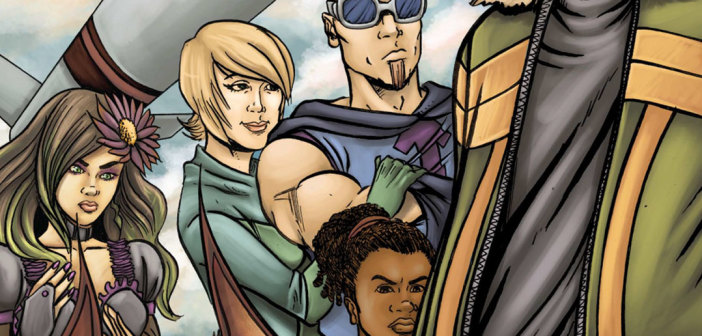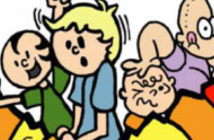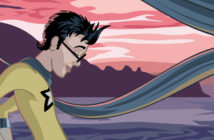Chris Garrett’s Turbulence questions a fantastic premise that’s been poking at my imagination for some time now: What if superhuman powers were gained through training and determination rather than chance accidents and evolutionary leaps? What variables would determine the powers developed? Would such superhuman abilities be like gaining muscle mass through weight-training, a practice that demands consistent work else it will all wither away? These are the questions I hope Garrett will answer as his comic develops, because they’re exactly what will make his title stand out from the others.
In the world of Turbulence, superheroes and villains alike band together into META teams to do battle against one another like in any other super-powered comic book. What makes this book a bit different, even a bit special, are the unfortunate circumstances that surround the comic’s main character and namesake: Jacob Warrenford, a.k.a. Turbulence.
This rogue teen once grew up as a docile lay-about that would snooze wherever he wanted, whenever he wanted. It wasn’t until tragedy struck his pilot father that Jacob was shaken awake to realize life was something he had to take a hold of for himself. This isn’t an Uncle Ben copout; the beginning pages that reveal the main character’s origins are my favorite in the book.
As the rest of the story unfolds, the plot is a bit cloudy concerning the significance of what exactly is going on. There’s a standard mall chase where Jacob shows off his powers (he’s able to manipulate air currents); followed by some bad-guy busting and the introduction of a META team that is keeping a close eye on Jacob.
The group interested in the young Turbulence is led by Gravnos, and as his name implies, he’s capable of whipping up a game of “Light as a Feather, Stiff as a Board” on the spot with any object he wants. The rest of his team includes: Haku, a martial artist who is training his body to the peak of perfection; Flutter, a young girl with wings; and Victoria, a twenty-something with the ability to create flora by absorbing water. Gravnos is interested in recruiting the wild Jacob onto his team; yes, the kid is still rough around the edges, but with some work, there’s the spirit of a great hero in Jacob and his Turbulence identity.
Turbulence works for me most when I’m allowed a peak into the inner psyche of Jacob, an all-American kid trying to find his identify in an unpleasant world. I’m not much for teams books across the board, whether they’re released by Marvel Comics or Ronin Studios, so the standard back-and-forth super-powered swashbuckling usually doesn’t make my jaw drop one way or the other. There’s nothing wrong with the action in the book—it’s just not something that left me thirsting for more.
But there’s a reason why, for example, Matthew Murdock’s Daredevil is the Marvel superhero I cherish the most. He’s a pavement-pounding rogue: independent, flawed, and very human. I sense those same qualities in Jacob Warrenford, and working off of the book’s premise, he has to have accomplished something if he’s earned his powers, but so what? So he’s earned his powers. The character is still a sensitive kid, new to the game and learning the ropes. I hope to see more of this conundrum in future issues of the comic.
A genuine selling point of the book that remains consistent throughout is artist Marlin Vans’ illustrations. I’m not sure where she’s been keeping her talent hidden away, but if Turbulence is her first major stab at the comic book medium, she deserves a round of applause. Every page is consistently solid in its appearance and each character is alive with a unique presence. But this isn’t something that would have been possible without the colors of Saido (one name only for the purpose of this book), who provides rich tones that compliment Vans’ pencils like a glove fitting a hand.
The first issue of Turbulence is an overall strong start, but its ultimate triumph is teetering and tottering on the very plot point that makes the book worthwhile. I fear that Garrett might shoot himself in the foot by ruining a fantastic concept before it’s even had a chance to start rolling; I base this on the last few pages of the issue.
Yes, the press blurb for Turbulence states that heroes and villains “earn” their abilities, but Garrett might have shown his cards too early in the game by introducing an arbitrary character with far too much omnipotent sway over the book’s plot. That’s all I’ll say for now, as it’s early yet and I can’t read the writer’s mind. But while we’re all on the topic of superpowers we’d like to earn, I must admit that psychic abilities have always been high on my list.
This comic book review originally appeared on Broken Frontier on 30 December 2009.




